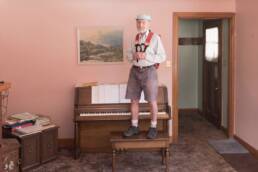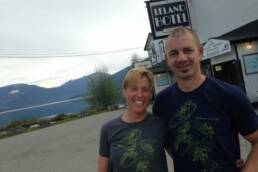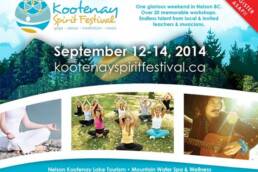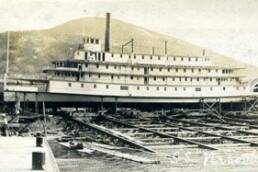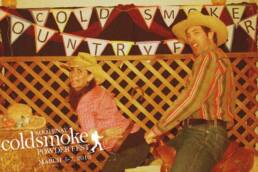Want to live to 100? While science has discovered mountain zones around the globe – from Pakistan to Greece to Japan – where centenarians are thriving, KMC Magazine Editor Vince Hempsall reports there’s more to a life of longevity than big walks over the hill.
Bob Dean has a giant wound on his leg. He sits in a worn armchair in his comfortable Nelson, British Columbia, bungalow wearing a sweater, shorts and wool socks. The gash on his right leg is hard to miss, all red, inflamed and long. “Oh, it’s nothing,” he says when I ask him about it. “I was crossing a creek when I snagged my shin. Looks worse than it is.” This wouldn’t be that remarkable—the scrape is the kind most schoolyard kids brandish—except Dean is 90 years old.
The steep 1.8-kilometre trail that he most frequents leads to a Nelson overlook called Pulpit Rock. He hikes it most days in about 30 minutes, even in winter. He’s a slight man with pointy ears and a white beard, and because of his inexhaustible energy, most guess his age to be 70. It’s a number that makes him chuckle. “I didn’t bother hiking Pulpit until my seventies,” he exclaims. “Before then I was doing real hikes in the mountains.” When asked about the secret of his vitality, he pauses, looks around his sparse living room with its couch, chair and upright piano, and replies, “No television.”
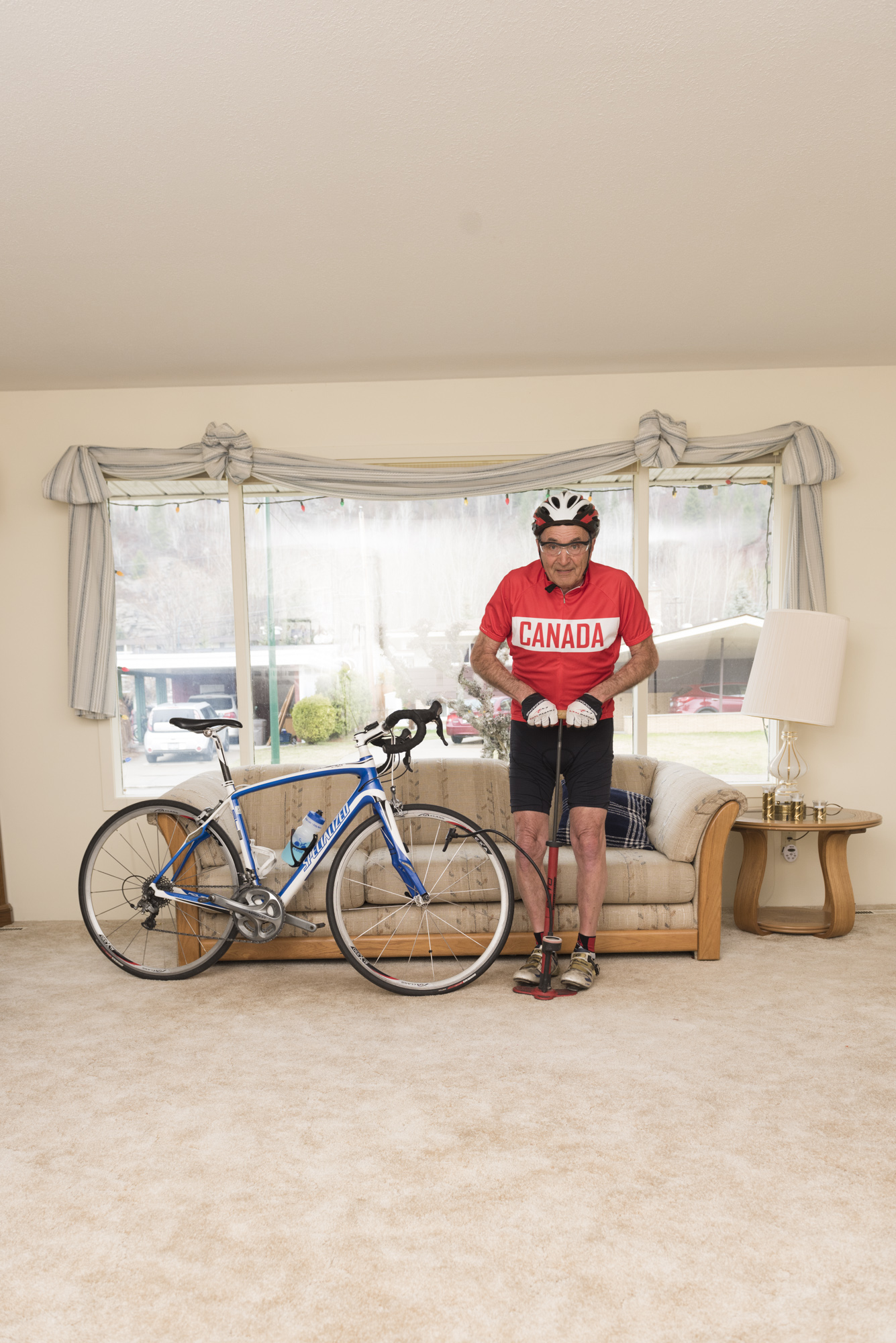
Some might credit Dean’s longevity and vitality to genetics, but science has proven there’s more to it. In fact, there are seven distinct areas on Earth where centenarians—people who are at least 100 years old—thrive. Each location shares remarkable similarities with the Kootenays. Yet, surprisingly, this region has the lowest life expectancy in British Columbia (excluding the province’s north), which begs the question, if we have access to a fountain of youth, why aren’t we tapping it?
According to the Provincial Health Services Authority, British Columbia residents enjoy the highest life expectancy in the country, with an average of 82.3 years, six months longer than the Canadian average. But both East and West Kootenay residents can expect to live to 80.9, almost a year and a half less. To discover why this is and how we might counteract it, we researched centenarian populations around the world, as well as local seniors who have bucked the trend and who are still going strong.

Longevity has always fascinated scholars, but its global study is a recent phenomenon. In the early 1970s, Dr. David Davies travelled to the mountainous Vilcabamba Valley of Ecuador where he discovered and then wrote, “a lifespan of 100 years is regarded as unexceptional.” He noted the plethora of 80- to 100-year-olds there when, at the time, the life expectancy in the rest of Ecuador was 59, and he was amazed by the fact that they were all active. Most were still hiking the steep slopes of the region, harvesting fruit and tilling soil.
Other geographic regions boasting active centenarians who are now under study include the Caucasus Mountains in southern Russia; the Hunza River Valley in north Pakistan; Okinawa, Japan; Sardinia, Italy; Nicoya, Costa Rica; and Icaria, Greece. Many of these regions came to be called “Blue Zones” because Belgian demographer Michel Poulain liked to mark them on maps with blue circles. The one major thing they all have in common? Mountains.

“Mountainous regions offer cleaner water, cleaner air, and the terrain requires us to constantly move up and down,” says 78-year-old Kaslo, British Columbia, resident Dr. Laurence Moss. “Plus, it’s a dynamic environment. The weather’s always changing, for example, which means we inhabitants are better at coping. We’re more resilient and less anxious when change happens.” Laurence has a Ph.D. in urban and regional planning and has lived in cities such as New York and Indonesia’s capital, Jakarta, as well as mountain towns in Europe, North America and Southeast Asia. An avid fly fisherman, he settled in Kaslo, about 70 kilometres north of Nelson, a decade ago for the great fishing and culture, making a point of getting outside every day, which is another commonality all Blue Zone residents have. It’s also a distinct commonality of each person interviewed for this story. Diets varied as did personality types. Some watched TV, some shunned it. Some had parents that lived to an old age and others didn’t. What they did all share, though, was the desire, the need, to get outdoors.
In his book, The Blue Zones Solution: The Revolutionary Plan to Eat and Live Your Way to Lifelong Health, researcher and author Dan Buettner describes the similarities of various centenarian populations and, notably, genetics is only listed as a key influence in Sardinia. More importantly, he says, residents who live in mountainous environments, have a sense of community and of individual purpose, take time to rest and relax, and they all spend large portions of their days outside.

Castlegar resident Wilma Turner says the first thing she does every morning is get out for a two-mile walk in her hilly neighbourhood. The 86-year-old credits her vigour in part to those she surrounds herself with, including her kids, grandkids, friends and her husband, George, who, at 87, still gets a hunting license every year. “If he lives with me he has to be active!” she says emphatically. As for her advice on longevity, she recommends, “Get busy! If you don’t use it, you lose it. Do what you love…or try something new. But don’t try drugs. They’re not going to help you much.”
Rino Dibiasio certainly gets busy. The 82-year-old Trail native has been ski patrolling at Rossland’s Red Mountain Resort for the past 62 years, and he’s currently with the volunteer ski patrol. When he’s not at the hill, he spends his days cross-country skiing before hitting the gym in the evenings for good measure. During the summer, he bikes and trains for various senior games around North America. “You don’t want to spend all your time around the TV,” he says. “Don’t be a couch potato. Have an active lifestyle and just keep going.”
George Coletti concurs. He’s lived in Nelson most of his life and says he’s climbed just about every mountain in the area and fished every lake. These days he limits his fishing to the west arm of Kootenay Lake, but he tends his garden daily and gets a hunting license every year. Not bad for a 95-year-old. “We’re fortunate because we live where we can stay active. That’s a big part of it,” he says. “Don’t give up the things you love doing.”
IF WE’RE SO FORTUNATE, why aren’t there more approaching centenarians clogging up our singletrack? Many of our seniors fall into the category of “lost generation,” a term used in Psychology Today that refers to a generation considered to have lost societal value, importance and the ability to contribute. So how can we all enjoy a longer, more active life? “Put your iPhone in the garbage can,” answers Castlegar resident, Bert Port, a significant contributor to the mountain lore of the Kootenays. Port was a member of the first party to ski the Spearhead Traverse, near Whistler, British Columbia, in 1964. He did it a second time in 2014—at the age of 82. He had to purchase new ski equipment for his latest trip, prompting his wife Sue to regularly tell this joke: “What’s the definition of an optimist? An 82-year-old who buys all new touring gear.”
Like the Ports, Ken Holmes is an active member of the Kootenay Mountaineering Club. He regularly skis and hikes the trails in his hometown of Rossland, and last year he went on a rock-climbing trip to Kalymnos, Greece. When he hears Sue’s optimist joke, he laughs then retorts, “Actually, the real definition is a 78-year-old guy who gets his rock shoes resoled.”
If we all stay active in the outdoors, get involved in the community, relax often and enjoy fresh mountain air and water, we should be able to hike until we’re 100, right? Not quite. For one, we’re not as isolated as other Blue Zones, which means we experience more of an influx of processed foods, contagions and, ultimately, people. As Canada’s population ages and people look to escape crowded urban centres for more remote areas, we could see a rise in our elderly population. And that might be a good thing if the newcomers prescribe to the tenets of mountain culture. However, more people can also mean more development, and, as Dr. Laurence Moss warns, “We need to actively resist our mountain towns turning into the next Aspen.”
Dr. Moss also says that recreating here simply isn’t enough to ensure a long, vital life. “If you’re using recreating appropriately, that is you are “re-creating,” then yes, you could live longer and better,” he says. “But if you’re just zipping through the mountains, chasing that thrill, don’t expect to get the deep benefits that come from being immersed in a mountainous environment. Your attachment to it is too superficial. That’s kind of a hard statement, I know, but it’s true. When I was younger, I was a competitive downhill skier and that is a very different experience from fishing a mountain stream, where I’m truly immersed in the arteries of the Earth.”
Every person interviewed for this story spoke of the outdoors with reverence. They were not stoked on the sick line they had just slayed or their king-of-the-mountain Strava time. They simply recognized a regular need to get outside and interact with the environment. Bert Port says he often goes into the Drinnon Lake area for a few nights by himself. “It’s an experience,” he says. “It forces you to be more aware. Not just because of accidents, but because you feel more connected to everything.” Ninety-five-year-old George Coletti has also been known to go on solo excursions on the lake. “One day, I was out there in my rowboat, and it was so beautiful I just stopped, took it all in and thought, ‘Lord, if there isn’t a heaven then please just leave me here.’”
Whether you’re into hiking, paddling, skiing, biking or any of the many outdoor activities available in the Kootenays, Dr. Moss says, “They are all thrilling pursuits in their own way. But if you want the cherry on the sundae…the long healthy life…then it’s a total experience. It’s about being a part of it. You come to realize that through recreation, even if it’s just going for a walk outside, you are connected. It’s a knowing that you’re a part of something greater. And that’s as close as you get to nirvana.” In other words, if you want the fountain of youth, there’s every good chance you’ll find it in the Kootenays. But first you must learn to sip slowly. It’s going to be a long ride.
Vince Hempsall
Vince Hempsall lives in the beautiful mountain town of Nelson, British Columbia, where he spends his time rock climbing, backcountry skiing and mountain biking (when not working). He is the editor of Kootenay Mountain Culture Magazine and online editor for the Mountain Culture Group.
Related Stories
Kootenay Couture: The 100-Mile Outfit
With earth-friendly buying emphasizing local main-street economies, we thought it was time to take on local high…
Kootenay Coldsmoke Yeehaw!
Another year of Kootenay Coldsmoke Powder Fest good times goes down in the history books. As the MC for the Powderkeg…


